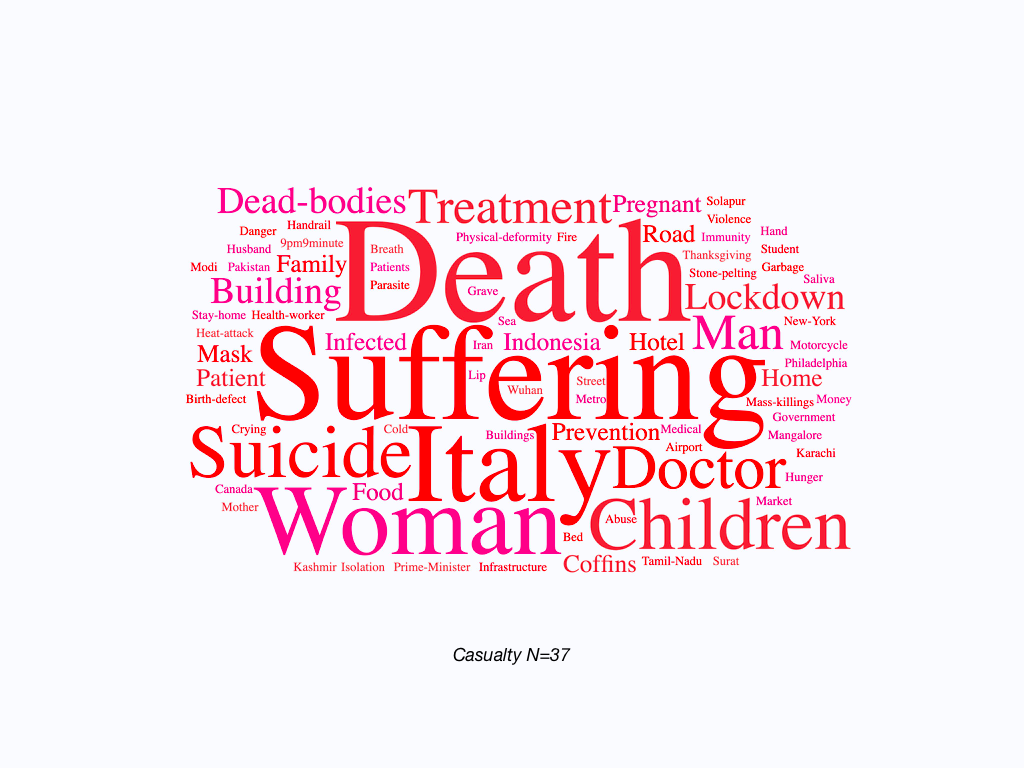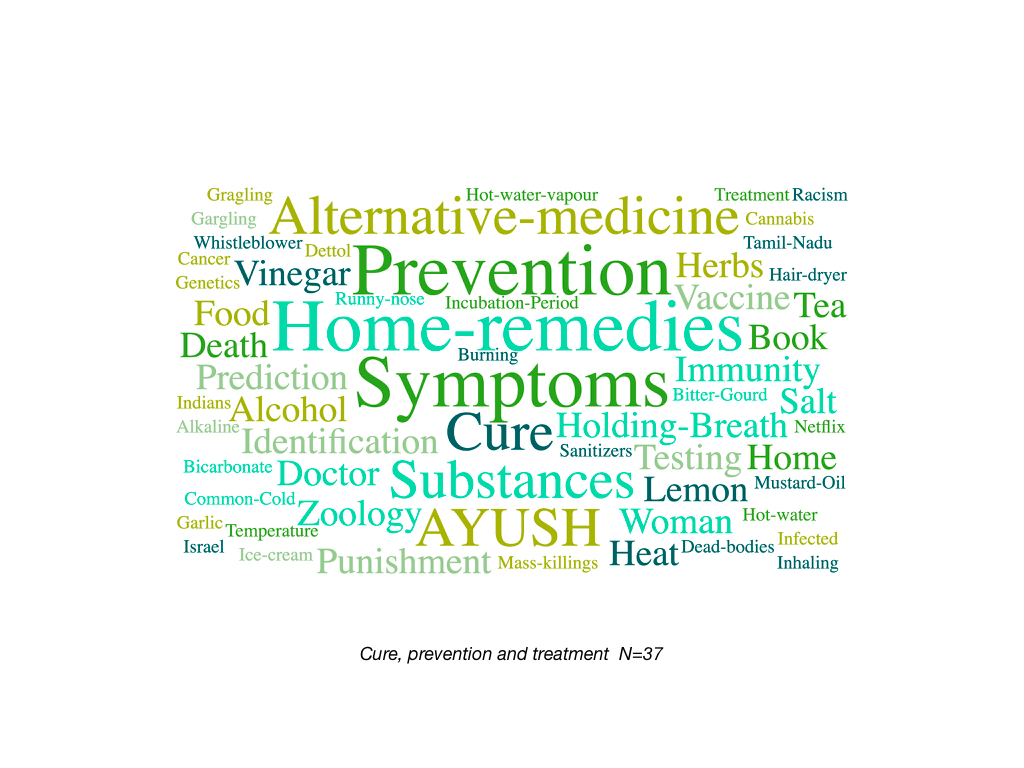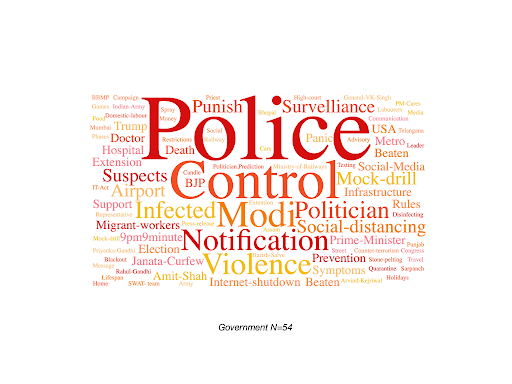Syeda Zainab Akbar, Divyanshu Kukreti, Somya Sagarika, Joyojeet Pal
(Suggested Citation: Akbar, S., Kukreti, D., Sagarika, S., Pal, J. (2020) Temporal patterns in COVID-19 related digital misinformation in India. Available online at: https://joyojeet.people.si.umich.edu/an-archive-of-covid-19-related-fake-news-in-india/)
Following up on a preliminary survey of debunked COVID-19 related messages online, we sought to understand how the kinds of misinformation have changed over the last few months.
Methodology
We sampled 243 unique misinformation instances from an archive maintained by Tattle Civic Technology, representing all the debunked stories from the following IFCN certified fact-checkers: AltNews, BOOMlive, Factly, Indiatoday Fact Check, Quint Webqoof, and NewsMobile Fact Checker during the time period of Jan 23, 2020 to April 12, 2020. We systematically annotated each story for thematic-categories, representative-tags, source of claims & attributions and medium of propagation. Our annotations are limited to the information the fact-checking organisations detail in their debunking reports. This period has been the main period of news and public figure coverage of the novel coronavirus, intersecting with the early reporting around students from India in Wuhan. A detailed study of COVID-related Twitter activity in India around this period is available here.
Findings
First, we find a rise in the number of debunked misinformation, especially following the third week of March. The momentum of misinformation had already started an upward trajectory before PM Narendra Modi’s announcement of the Janata Curfew, though since that week, the increase has been consistent.

We expanded our initial classification to encompass the broad themes that defined the various kinds of misinformation being spread. Table 1 below describes the definitions of the categories we used, and the instances of each kind of misinformation.
| Category | Instances | Definition | |
| 1 | Culture | 62 | Messages with cultural references such as to a religious / ethnic / social group or a popular culture reference |
| 2 | Cure, Prevention & Treatment | 37 | Messages suggesting remedies (alternative or mainstream), preventive measures, and vaccines-related misinformation |
| 3 | Nature & the Environment | 16 | Messages that have references to animals and the environment. |
| 4 | Casualty | 36 | Messages relating to deaths, illness of people in the pandemic, including graphic images of suffering (not including doctored statistics) |
| 5 | Business and economy | 15 | Messages relating to scams, panic-buying and target businesses with fake positive cases. |
| 6 | Government | 54 | Messages have government announcements and advisories or refer to police, judiciary, political parties. |
| 7 | Doctored statistics | 23 | Messages that have exaggerated numbers of positive cases or death counts and fake advisories. |
We see in the figure below that two categories of misinformation have been rising consistently – stories around culture and the government. This is due to a visible increase in stories around Muslims and COVID-19 as well as stories around police brutality. In contrast, stories around casualty – or graphic imagery around COVID-19 infection or death as well as stories around cure peaked and started falling.
As we see it, we are entering a phase in misinformation which is intended to be affective around identity and emotion rather than around instrumental facts that can be scientifically verified. Thus, from presenting fake cures or fake images of pain – which over time get debunked or appear suspicious to viewers, the misinformation has moved to cultural elements that are harder to verify.

Content patterns
We find that the types of content relied upon to relay different kinds of misinformation varies. For instance, misinformation in the category “casualty” relies heavily on visual content, since the goal of these is to invoke a physical reaction, often fear or disgust. In contrast, tweets on cures and misleading statistics use a high amount of text, because the goal with these is to mislead by offering specifics.

Temporal Patterns
We created wordclouds of the tags used to annotate the stories in a key 30-day period between March 14 and April 12 to see if there are any trends. The images below show that while the first period in the lead up to the lockdown was dominated by discussions of a possible lockdown and about infections, gradually the discourse changed to Muslims and religion more significantly.

The image above helps visualize the ways in which the discourse moved gradually towards Muslims in the misinformation universe.
Invent or Repurpose
We examined the type of content, based on whether the creator of the misinformation had created entirely new content or repurposed old content. We find in figure .. that content categorized as culture or casualty are most likely to be repurposed older content. Since both these categories of content seek to create an emotional affect in the viewer, the creators often seek out explicit content that is shocking and repurpose it with a false heading since it is likely to have greater shock value. We used this terminology of fabrication and repurposing from a recent study by the Oxford Internet Institute on types, sources, and claims of COVID-19 misinformation.

Attribute to claim
We see that different types of attribution are used for different categories of misinformation. The differences in these help us understand ways in which certain sources may be perceived as more reliable for certain kinds of affect.

As we see above, politicians or institutions are more likely to be used to perform a believable source for government-related misinformation, whereas businesses are seen as more valuable means of misguiding a reader on cure or issues of the economy. Likewise celebrities are more likely to be used in culture-related misinformation, while formal institutions are more frequently used to help push doctored statistics.
Politicians / Government as spreaders of misinformation
While we do not have any data on political complicity in the spreading of misinformation, there have been instances where politicians or arms of the government have directly passed along information that has been found to be false.
The above screenshots show that while the majority of politicians to have spread misinformation tend to be low-level politicians, we also find instances in the data when formal arms of the government, such as the Press Information Bureau (PIB) have spread misinformation.
Public figures as spreaders of misinformation
Public figures can play an important role in the management of misinformation, as we note in this document, celebrities are often attributed in misinformation to give an artifact more credence. However, there have been times when widely followed public figures have themselves contributed to misinformation.

We see here debunked information from businessperson Kiram Mazumdar Shaw, as well as two anchors of widely consumed news sources. For instance, Shaw tweeted that countries in the Southern Hemisphere remain unaffected by the coronavirus outbreak, while this claim was clearly dubious from the start, her engagement with it gave the idea some credence and led to widespread engagement online before and after it was debunked.
Mainstream media as spreaders of misinformation
From our data we found that news sources ranging from less widely consumed, regional digital news to heavily engaged national news have been complicit in spreading misinformation. In the image below, we have We screenshots of news channels including ANI, TOI Kochi, TV9, Global Times, OPIndia, News18 all participating in the circulation of misinformation.

The reasons for mainstream media sharing misinformation are unclear, some may simply be out of poor editorial standards in a highly competitive media ecosystem, but it is clear that misinformation travels very fast, and that news sources may increase footfalls through deliberate misinformation or through clickbait headlining. Interestingly, the majority of misinformation in this are from the “culture” category, suggesting that mainstream news sources have been particularly complicit in Mulsim-baiting.
Categories of Misinformation
Business & the Economy
We classify messages under business and economy when messages relate to scams, panic-buying and target businesses with fake positive cases.

As we see above, the majority of misinformation here is intended to create some form of panic such as stories about essential commodities disappearing, fake shutdown notices of businesses and cash shortages.
Casualty
We classify a message under casualty when they refer to fear-invoking messages related to deaths, suicides and suffering of people in the pandemic. These messages are distinct from death statistics in that they deal with the viscerality of the condition, such as descriptions of symptoms, visuals of death and suffering etc, intended to cause distress in the viewer.

A large share of the casualty-related messages were driven by the increase in casualties in Italy. As with other forms of content intended to incite fear, there are images/videos of dead-bodies, people suffering and of women & children in pain.
Culture
We classify messages under culture when these are about a religious / ethnic / social group or have a popular culture reference. As the visualization shows, culture-related misinformation has a very significant Muslim/Islam-related component.

While there was a significant China-related component in the earlier stories, as the coronavirus spread increased in India, religious references appeared in increasing numbers later. Muslims became an important part of the misinformation spread as spreaders of the coronavirus and provokers of chaos and violence, following the Nizamuddin Markaz incident.
A frequently seen feature of culture-related misinformation is that they often rely on the use of a publicly recognized figure to grab attention of the reader. In this case below, Yoga master Baba Ramdev is presented to give credence to a misinformation claim that makes a cultural reference at Ayurvedic / Hindu practices.
| False claim: Baba Ramdev is hospitalised as he drank excess of cow-urine to avoid being infected by Coronavirus | This is actually an image of Baba Ramdev in the hospital after his 9-day hunger strike against black money. Older photographs of celebrities are associated with new events to increase believability and also bring more engagement with posts. | https://www.altnews.in/fact-check-ramdev-coronavirus-cow-urine/
Source: AltNews |
……………………………………………………………. |
The rise in ‘Culture’ related misinformation is not just attributable to negative messaging about Muslims. A large number of “positive” misinformation emerged both after PM Modi’s request to citizens to clap for health workers, and thereafter his next request to have citizens light up candles. Both led to misinformation about traditional scientific logic behind the move. The increase in culture-related misinformation also has related to ‘cure’ related tweets that lionize traditional knowledge such as Ayurveda, which also saw a brief spurt following the PM’s announcement.
Cure, Prevention & Treatment
We list under Cure, Prevention and Treatment messages suggesting remedies (alternative or mainstream), preventive measures, and vaccines-related misinformation.

We see two distinct trends – first is that of home remedies (including terms such as lemon, vinegar etc.) and alternative medicines (Ayush, herbs etc). While cure-related misinformation was very significant early in the COVID spread, it gradually fell with the passage of time, since the remedies did not work, and they reached a saturation point, to use a COVID metaphor, there was herd immunity to some of the claims of alternative cures as it became increasingly clear from official sources that there was none.
We find that cure-related misinformation has a higher share of institutional attribution to support its claims. An example from a debunked story below shows St. Luke’s hospital of Kansas City was attributed with a claim that alcohol helps reducing risk of COVID-19. An official-looking logo and letterhead are used to make the claim seem real.
| Claim: Saint Luke’s Hospital advised that consuming alcohol helps reduce risk of Coronavirus | The hospital released that the advisory with alcohol as recommended cure is fake. The hospital’s letterhead was used to legitimise the claim. | https://www.indiatoday.in/fact-check/story/coronavirus-fact-check-claims-on-alcohol-and-covid-19-1654812-2020-03-12
Source: India Today |
 ……………………………………………………. ……………………………………………………. |
Doctored statistics
Messages that have exaggerated numbers of positive cases or death counts and fake advisories. A look at the wordcloud shows that institutions are often used to substantiate claims. Thus UNICEF, WHO or specifics about places where the statistics are from are cited to make them more believable.

Institutions are often used to convince a reader of doctored statistics, in the case below, the World Health Organization is purported to have sent a message relating to India’s lockdown measures.
| Claim: WHO has released a protocol for Lockdown to control the virus, supporting India’s lockdown measures. | Fact: WHO released a statement refuting the attributed messages. The name and stamp of the institution has been used to build false authority. | https://www.altnews.in/viral-whatsapp-forward-of-who-lockdown-protocol-is-fake/
Source: AltNews |

…………………………………………………… |
Government
We classify here messages have that purport to have government announcements and advisories and refer to police, judiciary and official institutions.

As we see here, there is a significant component of tweets about the police, much of which is about police brutality, posts about which increased significantly after the lockdown began, and some legitimate news of police attacks on citizens started to surface
In terms of legitimating claims of misinformation related to government agencies, governments or politicians, who can be projected as having inside information on the story, are frequently used, as in the story below, where doctored visuals of an interface from a news source alongside a claim that Narendra Modi himself proposed an internet shutdown.
| Claim: PM Narendra Modi announced a shutdown of internet services for a week to avoid panic in public through social media. | Fact: No internet shutdowns have been announced. Fake Graphics with PM’s photograph and Aaj Tak news channel logo has been used to legitimate the claim. | https://www.boomlive.in/fake-news/no-pm-modi-has-not-announced-an-internet-shutdown-during-lockdown-7405
Source: BoomLive |

……………………………………………………. |
Nature & the Environment
Messages that have references to animals and the environment. There were two distinct strands around this heading. The first was around origins of the virus and nature-related potential causes, the second has been on the impact of the virus on nature.

One oddly popular thread of misinformation has been around “reappearance” – ranging from messages about animals roaming the street (again, there have been a small number of actual reported stories of animals out and about in various small towns and villages) such as herds of deer gathered on the Ooty-Coimbatore road to bizarre misinformation about mermaids appearing as a result of reduced human impact on the environment.
Link to data.
